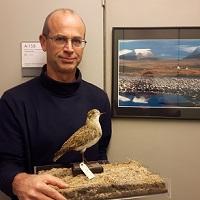First back in time
This beautifully prepared specimen in the display case had to miss the return trip to his breeding grounds in the tundra, but now helps us to tell his extraordinary travel stories as well as a piece of VU history. He reminds us of the illustrious period of zoological research here in the last century, to which we still owe a special collection of stuffed animals, skeletons, fossils and plants in beautiful paper herbarium folders. These are now used mainly for teaching purposes, including by myself; with thanks to colleagues such as René Thijssen, Peter Maas, Kees Wattèl and Fred Wolff for their good care of this collection and its display cases over the decades.
In the last century research on bird migration had high priority and this took place in particular at the VU field station the Groene Glop on Schiermonnikoog. This field station is still gratefully used for our ecological research and education, although the ringing research into bird migration is now done there by volunteers.
Parallel migration routes of bird and researcher
For me personally, research and hobby organically converge in the Golden Plover. Every year, as an ecological researcher, I travel several times after the Golden Plover to the High North, although the bird exhibits more climate-friendly migration behavior than the researcher. In Abisko, in Swedish Lapland, I have been doing experimental research for years with Rien Aerts and other ecologists into the effects of climate warming on the carbon balance and biodiversity of the tundra. With transparent "open-top chambers" we have been warming up a number of pieces of tundra land for almost two decades. In this area the "hieuuuw" of a Golden Plover, for me the symbol of the tundra, can be heard regularly. Perhaps I heard this same individual six months earlier in my own polder, I think.
Climate warming affects both the golden plover and myself. For the bird, it is important that the rapid expansion of shrubs, and sometimes trees, does not come at the expense of the open tundra it desperately needs as a breeding ground. For myself, hearing the whistle of the Golden Plover is the sign that it is not yet too late for bird and tundra. But it is five to twelve.niversity and science history.'
